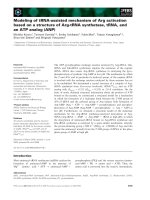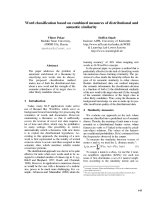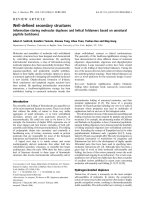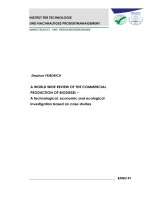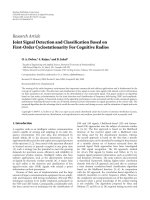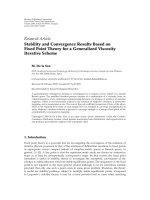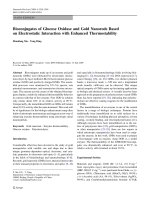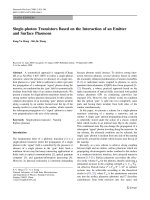Standstill agreements and market response based on ownership structure of rget firms
Bạn đang xem bản rút gọn của tài liệu. Xem và tải ngay bản đầy đủ của tài liệu tại đây (4.36 MB, 102 trang )
INFORMATION TO USERS
This manuscript has been reproduced from the microfilm master. UMI
f f lm s the text directly from the original or copy submitted. Thus, some
thesis and dissertation copies are in typewriter face, while others may
be from any type of computer printer.
The quality of this reproduction is dependent upon the quality of the
copy submitted. Broken or indistinct print, colored or poor quality
illustrations and photographs, print bleedthrougfa, substandard margins,
and improper alignment can adversely affect reproduction.
In the unlikely event that the author did not send UMI a complete
manuscript and there are missing pages, these will be noted. Also, if
unauthorized copyright material had to be removed, a note will indicate
the deletion.
Oversize materials (e.g., maps, drawings, charts) are reproduced by
sectioning the original, beginning at the upper left-hand comer and
continuing from left to right in equal sections with small overlaps. Each
original is also photographed in one exposure and is included in
reduced form at the back of the book.
Photographs included in the original manuscript have been reproduced
xerographically in this copy. Higher quality 6" x 9" black and white
photographic prints are available for any photographs or illustrations
appearing in this copy for an additional charge. Contact UMI directly
to order.
A Bell & Howell Information Company
300 North Z eeb Road. Ann Arbor. Ml 48106-1346 USA
313/761-4700 800/521-0600
Reproduced with permission of the copyright owner. Further reproduction prohibited without permission.
Reproduced with permission of the copyright owner. Further reproduction prohibited without permission.
STANDSTILL AGREEMENTS AND MARKET RESPONSE BASED ON
OWNERSHIP STRUCTURE OF TARGET FIRMS
by
Farooq I. Chaudhry
A Dissertation Presented in Partial Fulfillment
of the Requirements for the Degree
Doctor of Philosophy
ARIZONA STATE UNIVERSITY
August 1995
Reproduced with permission of the copyright owner. Further reproduction prohibited without permission.
UMI Number: 9539534
UMI Microform 9539534
Copyright 1995, by UMI Company. All rights reserved.
This microform edition is protected against unauthorized
copying under Title 17, United States Code.
UMI
300 North Zeeb Road
Ann Arbor, MI 48103
Reproduced with permission of the copyright owner. Further reproduction prohibited without permission.
STANDSTILL AGREEMENTS AND MARKET RESPONSE BASED ON
OWNERSHIP STRUCTURE OF TARGET FIRMS
by
Farooq I. Chaudhry
has been approved
July 1995
APPROVED:
, Chairperson
Supervisory Committee
ACCEPTED:
Dean of the College
Dean, Graduate College
Reproduced with permission of the copyright owner. Further reproduction prohibited without permission.
Abstract
A standstill agreement is a voluntary contract between a firm and a substantial
stockholder that limits the stockholder's ownership of voting shares to a maximum
percentage for a specific period. Management does not need approval of the shareholders
to enter the firm into the agreement. Specific characteristics of the agreement can vary by
situation but they can eliminate or restrict the ability of hostile stockholders to gain control
of the firm through contractual agreement, repurchase of stock, or both.
The finance literature provides mixed evidence of the roles that institutional
ownership and blockholder ownership play in monitoring firm management or how
monitoring affects managerial actions. Institutional and blockholder ownership may
substitute for insider holdings to align the interest of managers with those of the
stockholders through monitoring, especially when managerial holdings are small. When
insider holdings are large, the alignment benefits may be offset by the entrenchment
effects. However, external monitoring may still provide some discipline to managerial
actions.
I examine whether actions of target firms' managements in entering standstill
agreements are in the best interest of their nonparticipating shareholders. I approach this
task by cross-sectionally analyzing the abnormal returns during a three-day window for
the announcement date of the standstill agreements using several variables that proxy for
the ownership structure of target firms. The announcement period abnormal return for 249
observations is a statistically significant -0.5 percent. However, investors do not suffer
any loss when you consider abnormal returns for the whole control event. A non-linear
iii
Reproduced with permission of the copyright owner. Further reproduction prohibited without permission.
relationship exists between insider ownership, block ownership and institutional ownership
and the announcement period abnormal returns. Positive abnormal returns exist for all
firms in the pre-event period, except for a group of firms with over 25 percent insider
ownership. The average announcement period return is negative for NYSE firms, but it
is positive for non-NYSE firms. All non-NYSE firms, except those having insider
ownership between 5 to 25 percent, experience a negative average abnormal return of 10
percent or more after the agreement. Institutional ownership has a negative correlation
with the announcement effect in the under 5 percent group. This result suggests that
institutional monitoring in this group is ineffective. The opposite effect exists for the 5 to
25 percent group, suggesting that when management enters a standstill agreement it does
so for the good of the firm. When both a confidentiality and standstill agreement is
present, significant abnormal returns exist and the firms have a change of control within
three years of the agreement.
iv
Reproduced with permission of the copyright owner. Further reproduction prohibited without permission.
Acknowledgments
I am most grateful to Dr. George Gallinger for his time and patience in reading and
guiding me in the research process. I am also deeply grateful to Dr. Herbert Kaufman and
Dr. Linda Martin for their help on my dissertation committee and their constructive
comments. Special thanks to Peter Luan for help with computer problems and Dr. Ibrahim
Helou for his continued moral support in completing this project. I am also indebted to Dr.
Richard Smith for encouraging me to work on the topic of standstill agreements.
My greatest debt is to my parents who instilled in me the desire to seek knowledge.
My parents died in a car crash when I was fourteen years old and it is on occasions like
this that I miss them terribly. I am sure they would have been very proud of this
accomplishment, and how I wish I had them around to join me in my joys and sorrows.
v
Reproduced with permission of the copyright owner. Further reproduction prohibited without permission.
Table of Contents
List of T a b le s ......................................................................................................................... vii
1. Introduction ...................................................................................................................... 1
2. Literature Review and Hypothesis D ev elo p m en t........................................................... 7
2.1 Convergence-of-Interest Hypothesis
vs. Management Entrenchment Hypothesis .............................................. 10
2.2 Other H y p o th esis...........................................................................................
13
2.2.1 Ownership Structure and Corporate Value ................................. 13
2.2.2 Blockholders as Monitors
...........................................................
19
2.2.3 Institutional M o n ito rin g .................................................................... 20
3. Data and Methodology
....................................................................................................24
3.1 Identification of Sample and Measurement of Abnormal R e tu r n s
24
3.2 Modeling Abnormal Returns Occurring on ED A Y ...................................... 29
3.3 Data Summary D e sc rip tio n ...............................................................................36
4. Empirical Results ............................................................................................................44
4.1 Average Abnormal Return Results
................................................................. 44
4.2 Cross-sectional Analysis of the Announcement E f f e c t ................................. 59
5. Conclusions
...................................................................................................................
82
R e fe re n c e s...........................................................................................................................
89
vi
Reproduced with permission of the copyright owner. Further reproduction prohibited without permission.
List of Tables
1
Definition of dummy variables corresponding to different time periods relative to
the announcement of standstill agreement............................................................. 27
2
Definitions and expected signs of the coefficients of the variables used in the crosssectional regression explainingthe announcement effect of standstill agreements.
....................................................................................................................................30
3
Frequency distribution of standstill agreements by year, by number o f firms and
by stock listing.............................................................................................................37
4
Summary of descriptive statistics for 249 standstill agreement events pertaining to
202 firms from 1978 to 1992................................................................................. 39
5
Insider stock holdings, insider block holdings, other block holdings, institutional
ownership, and percent of target stock owned by the bidder prior to the standstill
event for the total sample and by NYSE and non-NYSE subgroups................ 42
6
Average abnormal stock returns reported for firms by exchange of listing and
various important c a te g o rie s................................................................................... 51
7
Average abnormal stock returns reported in three ownership subgroups for total
sample and by stock lis tin g ...................................................................................... 57
8
Model 1: Ordinary least squares regression analysis of various ownership variables
and other factors to explain the abnormal returns generated on the announcement
of standstill a g re em e n ts........................................................................................... 66
9
Model 2: Ordinary least squares regression analysis of various ownership variables
and other factors to explain the abnormal returns generated on the announcement
o f standstill agreements from 1978 to 1992. The number of institutional
stockholders is added to this model.......................................................................... 73
10
Model 3: Ordinary least squares regression analysis of various ownership variables
and other factors to explain the abnormal returns generated on the announcement
of standstill agreements from 1978 to 1992. t-statistics are corrected for
heteroscedasticity (White (1980)) and are noted in parenthesis under the respective
coefficients. An exchange dummy variable is added to this model......................80
V ll
Reproduced with permission of the copyright owner. Further reproduction prohibited without permission.
1. Introduction
A standstill agreement is a voluntary contract between a firm and a substantial
stockholder that limits the stockholder's ownership of voting shares to a maximum
percentage for a specific period.1 Management does not need approval of the shareholders
to enter the firm into the agreement. Specific characteristics of the agreement can vary by
situation but they generally include the following features. The agreement can eliminate
or restrict the ability of hostile stockholders to gain control of the firm through contractual
agreement, repurchase of stock, or both. The agreement often allows a substantial
stockholder to make either a friendly or an unfriendly cash tender offer for all shares
outstanding. In return, management of the target firm promises not to erect any takeover
defenses for a certain period. Frequently, a targeted repurchase or "greenmail" purchase
for all or part of the substantial stockholder's equity in the target firm accompanies the
agreement.2 Finally, the agreement usually requires potential bidders to vote as directed
by the target firm's management.
Popular perceptions of why management of a target firm enters into a standstill
agreement are threefold. First, Linn and McConnell (1983) argue that a standstill
agreement places management in a better position to bargain with raiders on behalf of
stockholders. The agreement allows time for a bidding war to occur with a higher price
for the stockholders as the expected outcome. However, it is puzzling why target managers
wait for an initial bid to do something about maximizing firm value. Target management's
^ h e use of standstill agreements between debtor and creditors, when debtor is in
technical default of loan agreement, is not the subject of this study.
2Greenmail is an offer by management to repurchase the shares of a subset of
shareholders at a premium. The offer is not made to other shareholders.
Reproduced with permission of the copyright owner. Further reproduction prohibited without permission.
passivity may support the "kick in the pants" hypothesis discussed by Bradley, Desai and
Kim (1983); that is, management is reluctant to do anything until forced by outside parties.
Second, the standstill agreement may provide management with cover to accept longer
term projects that appear to be unprofitable in the short run. Stein's (1988) managerial
myopia argument points out that the capital market systematically undervalues the delayed
payoffs on long-term investments. Takeover pressure leads managers to focus more on
short-term profits rather than on meeting long-term objectives. A standstill agreement can
relieve the pressure of having to attain short-term results. If management is able to
concentrate its effort on long-term investment projects, shareholders can benefit.3 Third,
the agreement may reduce expected legal costs. In most cases of managerial resistance to
a takeover attempt, bidders file lawsuits against the firm and its management. Bidders
claim that management's stewardship of the company leads to entrenched officers, which
is detrimental to stockholders. Regardless of the lawsuit's merit, the cost of a protracted
legal battle can be substantial to the target firm, thereby lowering returns to stockholders.
Limited empirical research exists about standstill agreements. Dann and DeAngelo
(1983) studied 30 firms that entered standstill agreements and/or negotiated premium
targeted repurchases. They found that the agreements and repurchases resulted in
statistically significant negative average returns to stockholders.4 Dann and DeAngelo
3For example, management might be able to boost the stock price by selling off
productive assets that shareholders are unable to value properly. If left unsold, the assets
may have little effect on current earnings and may be undervalued by shareholders.
Consequently, this sale has an immediate impact on income and may cause an upward
revaluation of the company's stock.
4Many standstill agreements do not involve repurchase of stock from a bidder but
Reproduced with permission of the copyright owner. Further reproduction prohibited without permission.
conclude that their findings support a management entrenchment hypothesis and reject a
stockholder interest hypothesis. Mikkelson and Ruback (1991) find contrary evidence for
targeted repurchases but not for standstill agreements. They conclude that large
blockholders and targeted repurchases generally help, or at least do not harm,
nonparticipating stockholders of the repurchasing firm. They also conclude that the
importance of a standstill agreement is unclear because it does not restrict investments by
other potential blockholders.
Mikkelson and Ruback's (1991) logic is as follows. When you view the standstill
agreement as an isolated event, there is a stock price decline at the agreement date. This
result, they claim, leads Dann and DeAngelo (1983) to conclude that management of the
target firm harmed nonparticipating shareholders. However, when you view the standstill
agreement as the outcome of an ongoing corporate control process, the average stock price
decline, at either the announcement date or the stock repurchase date, suggests a
downward revision in the market's expectations. This price revision could be caused by
a realization that expected profitability of available investment choices is too high or
management chose an inferior investment alternative. Based upon Mikkelson and Ruback’s
(1991) research, it is not appropriate to evaluate managerial actions by observing just the
announcement period returns. For this reason I analyze abnonnal returns to firms entering
standstill agreements from the Schedule 13D filing date through to the change-of-control
date.
simply place a maximum limit of percentage ownership. Many targeted repurchases do not
involve a standstill agreement.
Reproduced with permission of the copyright owner. Further reproduction prohibited without permission.
The purpose of my research is to clarify the conflicting evidence reported by the
aforementioned studies. I examine whether actions of target firms' managements in
entering standstill agreements are in the best interest of their nonparticipating shareholders.
I approach this task by cross-sectionally analyzing abnormal returns during a three-day
window for the announcement date of the standstill agreements using several variables that
proxy for the ownership structure of target firms. I also follow Mikkelson and Ruback’s
(1991) argument and analyze firms involved in standstill agreements from the filing date
of Schedule 13D through the change-of-control date. The data set includes 249 standstill
events for the period 1978 to 1992. This sample consists of 217 concluded agreements and
32 cases where there is mention of a possible agreement. The announcement period
abnormal return for the 249 observations is a statistically significant -0.5 percent. The
announcement period abnormal return for 217 concluded agreements is a highly significant
-1 percent. The announcement period abnormal return for 32 potential agreements is about
4 percent, which is also significant.
There is a simple explanation for the different magnitude of abnormal returns for
the two subgroups. In most cases a standstill agreement is the outcome of an ongoing
corporate control process. It begins with the accumulation o f shares of a target firm by a
blockholder (potential bidder) who wishes to play a more active role in the affairs of the
company. The process ends with a standstill agreement and subsequent repurchase of
shares by the firm from the blockholder. The increase in average stock price associated
with an accumulation of shares indicates that initiating the corporate control process
benefits shareholders.
However, market participants are unable to distinguish
Reproduced with permission of the copyright owner. Further reproduction prohibited without permission.
blockholdings that will end in a repurchase and a standstill agreement from blockholdings
that will end with a more favorable outcome for the target firm's stockholders, such as a
takeover bid.
Because of the weak support found for effectiveness of institutional monitoring, the
benefits derived from such external monitoring may outweigh the potential public cost of
damages if there were no such restrictions. The fact that institutions provide some
monitoring has a public policy implication for the government to relax some of the
regulatory restrictions imposed on certain institutions because of the potential benefits of
institutional ownership. For example, the Investment Company Act of 1940 prevents a
mutual fund from calling itself a diversified fund if it owns more than 10 percent of the
stock of any single company. Also, the Internal Revenue Service allows only diversified
funds to pass income through to shareholders untaxed. Insurance companies must typically
limit equity investment to 20 percent of their assets and no single investment can exceed
2 percent of the assets. These restrictions result from regulatory concern about the public
costs of under-diversified institutions and may be costly if they unduly limit institutional
monitoring [see Eakins (1990)].5
In the next section, I provide an overview of the relevant finance literature. This
literature provides the basis for development of hypotheses and empirical predictions.
Section 3 describes the sources and methods used in data collection, data description and
5 An article in The Wall Street Journal (April 27, 1992) indicated that the SEC has
taken steps to simplify the procedure to be followed by institutional stockholders or
blockholders of a firm to communicate with each other. Institutions are not required to file
proxy documents in order to discuss issues of mutual interest outside the amiual
stockholder meetings.
Reproduced with permission of the copyright owner. Further reproduction prohibited without permission.
methodologies for both computation of announcement period abnormal returns and the
relationship between corporate control variables and abnormal returns at the standstill
agreement date. Section 4 presents the empirical results and a discussion of how the results
support the hypotheses and testable implications. Section 5 states the conclusions and
outlines future research avenues.
Reproduced with permission of the copyright owner. Further reproduction prohibited without permission.
2. Literature Review and Hypothesis Development
Bhagat and Jefferis (1987) argue that a conflict of interest between management and
shareholders cannot explain the persistence of standstill agreements, greenmail and
targeted repurchases. The authors state that the failure of shareholders to deal with a
standstill agreement and/or targeted repurchase through contracting suggests that these
actions are not a pure transfer of wealth. If they were, shareholders would contractually
bond management not to engage in such practices. While termination of a takeover threat
through a standstill agreement and/or a targeted repurchase always benefits incumbent
management through continued tenure, shareholders may also benefit. If management
forgoes any resistance to a takeover and ignores the use of a standstill agreement,
stockholders are likely to accept a tender offer at a lower price than the true worth of the
shares. Shareholders apparently recognize that some standstill agreements and/or targeted
repurchases are in their best interest while others are not, so they do not completely
prohibit such actions.6 This decision process by shareholders is consistent with the theory
developed by Leland and Pyle (1977). They show that managerial equity ownership
conveys information to outside shareholders about management's private valuation of the
firm. By observing the proportion of insider ownership and voting control of the firm,
shareholders can infer the motives and incentives of management in entering a standstill
agreement.
Ruback (1988) examines stock prices of target firms involved in unsuccessful
control contests and finds significant abnormal positive returns of 31 percent associated
6Management can easily prohibit greenmail or standstill agreements without
legislation, announcing a policy that prohibits the board and management from taking such
actions and abide by this policy.
Reproduced with permission of the copyright owner. Further reproduction prohibited without permission.
8
with the initial announcement of a control contest. At the termination announcement, these
firms realized statistically significant negative abnormal returns of about 10 percent. No
significant abnormal returns occur in the three years following termination o f the takeover
offer. Ruback concludes that negative termination announcement returns indicate that the
failed control contest is costly to shareholders of target firms. A failed contest also means
that opposition to a takeover bid can be harmful because potential bidders may abandon
the takeover attempt when target management resists. O f course, potential bidders may
instead choose to increase the offer price, thereby benefiting target shareholders. Ruback
argues that managerial opposition to tender offers is a gamble; the target firm may obtain
another higher bid or not. He concludes that losing the gamble imposes costs on
shareholders. Similarly, resistance to change-of-control through a standstill agreement
and/or a targeted repurchase may not always be a negative. Target shareholders benefit
if the firm's value increases because of a change of control or other managerial actions
after entering a standstill agreement. Stockholders lose in this managerial gamble if no
value-enhancing change occurs.
Mikkelson and Ruback (1991) analyzed abnormal returns to stockholders of 111
observations from the initial accumulation of blocks of stock through subsequent targeted
repurchases. Thirty-three of the observations were subject to a prior control event.
However, a tender offer for control or a merger proposal preceded only four targeted
repurchases.7 A standstill agreement accompanied 39 of the repurchases. They find an
7Mikkelson and Ruback (1991) include an observation as a control event when The
Wall Street Journal reports that a blockholder sought or considered seeking either board
representation or control.
Reproduced with permission of the copyright owner. Further reproduction prohibited without permission.
9
increase in the average stock price in response to the accumulation of shares and the
announcement of the blockholding. The average return is 7.4 percent from the time of the
initial blockholding until the repurchase. However, Mikkelson and Ruback argue that the
average stock returns mask the heterogeneity among repurchases. The authors find that the
average stock price change for a repurchase with a standstill agreement is positive but
statistically insignificant for the initial-accumulation-to-repurchase period. Yet, the average
abnormal return at an announcement of a targeted repurchase with a standstill agreement
is significantly negative. The authors suggest that much of the cross-sectional difference
between the abnormal returns is due to standstill agreements.
Mikkelson and Ruback (1991) find no obvious pattern to the use of standstill
agreements. There is no evidence of a higher incidence of standstill agreements associated
with known corporate "raiders" as opposed to non-raiders. The frequency o f change of
control for the repurchasing firm in the three years following the repurchase is virtually
identical for repurchases with and without a standstill agreement. Thus, standstill
agreements do not seem to target active investors who pose a threat to invest again, nor
do they successfully thwart changes in control. Furthermore, the authors cannot explain
why standstill agreements may harm shareholders of firms in which management
repurchases shares.
The persistent use of standstill agreements and the failure of capital markets to
restrict the ability of management to enter such agreements suggests that an important
function is served by these agreements. The following discussion develops hypotheses and
testable implications related to standstill agreement announcements.
Reproduced with permission of the copyright owner. Further reproduction prohibited without permission.
10
2.1 Convergence-of-Interest Hypothesis vs. Management Entrenchment Hypothesis
Shleifer and Vishny (1986a) argue that standstill agreements and other approaches
aimed at eliminating a bidder are not necessarily contrary to a shareholders' best interest
hypothesis. They show that management's defensive tactics can encourage a bidding
contest, thereby increasing the expected takeover premium and improving shareholder
welfare. Management may encourage uninformed potential acquirors to bid by providing
information necessary to realize a profit. However, prior to revealing the private
information, target managements generally require potential acquirors to sign a
confidentiality and standstill agreement.
An earlier study by Jensen and Ruback (1983) suggests that without the cooperation
of target management, bidders may encounter unwanted hurdles. They argue that a target
firm can benefit from delay in the release of private information to a potential acquiror to
promote information acquisition by other possible acquirors. In this way the target firm
conceals a "white knight" in the hopes that another bidder will surface so that the target
firm can capture a larger share of the takeover gains.8
Shleifer and Vishny (1986a) conclude that in a signaling equilibrium context share
prices always fall after payment of greenmail, even when managers appear to be
maximizing the long-run value of the firm. There are at least two possible reasons for the
decline in share prices. First, the market may respond unfavorably to information that
information collection is costly and target firm management wants other potential
acquirors to collect more information about its firm. If the target firm releases the
information that it has found a white knight, other firms may stop investing in the
information collection process.
Reproduced with permission of the copyright owner. Further reproduction prohibited without permission.
management has not found a white knight to buy the firm at a higher price. Second, the
market may have a negative reaction upon learning that the target firm entered into a
greenmail agreement, a standstill agreement, or some other managerial action to resist a
takeover.
Dann and DeAngelo (1983) note that when contracting is costless, managers and
stockholders resolve their conflicts by designing contracts to ensure that management
follows a stockholder wealth-maximization policy. The possibility of conflict of interest
remains when contracting is costly. However, sufficient constraints exist to limit the extent
of management's deviation from stockholder wealth maximization. Manne (1965) argues
that the threat of a takeover motivates management to act in the best interest of non
controlling shareholders. An implicit assumption of his argument is that managers do not
take unilateral actions which blunt the takeover threat to the detriment of stockholders.
Williamson (1975) does not entirely agree and notes that managers act opportunistically
to reduce any takeover threat, thereby expanding their perquisite consumption possibilities
at stockholder expense. Standstill agreements and privately negotiated repurchases are
opportunistic actions that incumbent management takes to reduce the threat of a takeover
by a large blockholder.
The convergence-of-interest hypothesis states that a standstill agreement with a new
blockholder can increase firm value through more effective monitoring of management,
through innovative ideas offered by a blockholder, or through takeover interest in the firm
by other investors. The target management's decision to repurchase an existing
blockholder's stake can help nonparticipating shareholders by facilitating a takeover by a
Reproduced with permission of the copyright owner. Further reproduction prohibited without permission.
12
third party, by eliminating a trouble-making investor or by eliminating a managerial
impasse about corporate strategy. At the other extreme is the management entrenchment
hypothesis. It suggests that target management may use stock repurchase with a standstill
agreement as a device to entrench itself by rejecting a higher-valued takeover bid.
Stockholders do not know ex ante which firms will enter standstill agreements. Nor
do they know if firms entering standstill agreements will eventually realize a valueenhancing change in control. Stockholders only know that some standstill agreements are
advantageous for them while others are not. If stockholders believe that management is
acting in their best interests by entering a standstill agreement, a positive announcement
period abnormal return supports the convergence-of-interests hypothesis. On the other
hand if stockholders believe that management is entering a standstill agreement to entrench
itself, the stock price should fall at the announcement date. A negative abnormal return
supports the management entrenchment hypothesis.
Ownership structure of target firms is an observable variable. Investors can use this
information to infer the incentives motivating management in entering a standstill
agreement and making other control related decisions. A significant correlation between
the ownership structure and the abnormal performance in the pre-announcement period,
the announcement period and the post-announcement period provides support for the
alternate hypotheses depending on the direction of the correlation. Analysis of abnormal
returns in the pre-announcement and post-announcement periods and their correlation with
ownership structure and other observable variables may allow the formulation of a trading
rule by an interested observer of the process.
Reproduced with permission of the copyright owner. Further reproduction prohibited without permission.
13
2.2
Other Hypothesis
Jensen and Meckling (1976) and Leland and Pyle (1977) develop theory to show
how insider ownership can affect the value of a firm. Brickley, Lease and Smith (1988),
Morck, Shleifer and Vishny (1988a,b), Pound (1988), Shleifer and Vishny (1986a, b), and
Stulz (1988), among others, have shown the impact of block ownership and institutional
ownership on the value of a firm. The following discussion reviews the relevant literature
and develops hypotheses relating to the impact of ownership structure on a firm 's share
price because of the announcement of a standstill agreement.
2.2.1 Ownership Structure and Corporate Value
The generally accepted theoretical view is that stockholders of a firm are a widely
dispersed and homogeneous group of relatively uninvolved absentee owners. Berle and
Means (1932) argue that when managers own little of the firm's equity and shareholders
are too dispersed to enforce value maximization, management deploys corporate assets to
benefit itself rather than shareholders. Thus, the firm's performance depends on the
distribution of share ownership between managers and others. Jensen and Meckling (1976)
>
provide a theoretical foundation of the relationship between corporate value and
management ownership. They divide shareholders into insiders (agent) and outsiders
(principal). Inside shareholders manage the firm and have exclusive voting rights. Outside
shareholders have no decision making rights. However, both classes of shareholders
receive the same dividend per share of stock held. A principal-agent problem arises
because the inside shareholder can augment the dividend stream by consuming additional
Reproduced with permission of the copyright owner. Further reproduction prohibited without permission.
14
perquisites. In this framework, insider owner-managers have incentive to adopt investment
and financing policies that benefit them but reduce the payoff to outside stockholders.
According to Jensen and Meckling (1976), the costs of deviating from a value
maximization strategy decline as management ownership increases. As their stakes rise,
managers pay a larger share of these costs and are less likely to squander corporate wealth.
According to the convergence-of-interest hypothesis, market value increases with
management ownership. As the proportion of shares owned by insiders increases, there
is greater alignment of insiders' interests with those of outside stockholders. Insiders who
own equity are less likely to enter a standstill agreement if they believe the agreement is
not in their best interests. Larger managerial holdings imply greater convergence of
interests and a smaller likelihood of entering the agreement to entrench management. In
a cross-section of firms entering standstill agreements, market response to the
announcement of the agreement should be positively correlated to the level of insider
stockholdings.
Demsetz (1983) and Fama and Jensen (1983) point out offsetting costs of
significant managerial ownership. These researchers argue that when management owns
a small stake, it will act in shareholders' best interests based on signals received from the
capital market [Easterbrook (1984), Rozeff (1982)], based on forces operating in the
managerial labor market [Fama (1980)], and based on the threat of an outside takeover
[Jensen and Ruback (1983), Manne (1965), Martin and McConnell (1991)]. In contrast,
if management controls a substantial fraction of the firm's equity, it may have enough
voting power or influence to guarantee continued employment with the firm at attractive
Reproduced with permission of the copyright owner. Further reproduction prohibited without permission.
15
salaries and may indulge in non-value-maximizing behavior. The entrenchment hypothesis
predicts that corporate assets can be less valuable when management is free of any controls
on its behavior. The main motivation of management in entering a standstill agreement
may be entrenchment.
Stulz (1988) offers a competing argument to the Jensen and Meckling (1976) view.
He focuses on the importance of the takeover market for disciplining corporate managers.
Stulz states that the premium a hostile bidder must pay to gain control of a target firm
increases as the fraction of equity owned by management increases. However, the
probability that the takeover will succeed decreases as equity owned by management
increases. When management owns a small fraction of the shares outstanding, it is more
likely that a hostile takeover will succeed at a premium that is less than the maximum the
bidder is willing to pay, ceteris paribus. As managerial equity ownership increases, the
probability of a successful hostile takeover for a given premium declines. If management
controls a sufficiently large fraction of votes and always opposes takeover attempts, the
value of the outside shares is lowest because investors never make a tender offer.
Empirical evidence exists to support Stulz’s views. Bradley and Kim (1985) show that
tender offers for firms in which insider ownership exceeds 20 percent are rare. Weston
(1979) reports that no firm in which insiders own over 30 percent equity has ever been
acquired in a hostile takeover. Thus, Stulz's reasoning implies that there is a unique
insider ownership value that maximizes the value of the firm. This reasoning suggests a
curvilinear relationship between the value of the firm and the fraction of shares owned by
insiders.
Reproduced with permission of the copyright owner. Further reproduction prohibited without permission.

